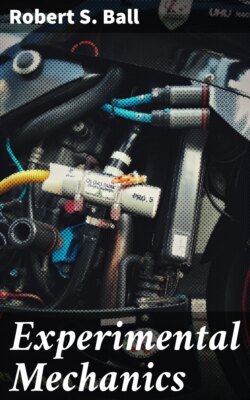Читать книгу Experimental Mechanics - Robert S. Ball - Страница 14
На сайте Литреса книга снята с продажи.
EXPERIMENTAL ILLUSTRATIONS.
ОглавлениеTable of Contents
Fig. 11.
28. The resolution or decomposition of one force into two forces each greater than itself is capable of being illustrated in a variety of ways, two of which will be here explained. In Fig. 11 an arrangement for this purpose is shown. A piece of stout twine ab, able to support from 20 lbs. to 30 lbs., is fastened at one end a to a fixed support, and at the other end b to the eye of a wire-strainer. A wire-strainer consists of an iron rod, with an eye at one end and a screw and a nut at the other; it is used for tightening wires in wire fencing; and is employed in this case for the purpose of stretching the cord. This being done, I take a piece of ordinary sewing-thread, which is of course weaker than the stout twine. I tie the thread to the middle of the cord at c, catch the other end in my fingers, and pull; something must break—something has broken: but what has broken? Not the slight thread, it is still whole; it is the cord which has snapped. Now this illustrates the point on which we have been dwelling. The force which I transmitted along the thread was insufficient to break it; the thread transferred the force to the cord, but under such circumstances that the force was greatly magnified, and the consequence was that this magnified force was able to break the cord before the original force could break the thread. We can also see why it was necessary to stretch the cord. In Fig. 10 the strains along the cords are greater when the cords are attached at c and d than when they are attached at a and b; that is to say, the more the cord is stretched towards a straight line, the greater are the forces into which the applied force is resolved.
29. We give a second example, in illustration of the same principle.
In Fig. 12 is shown a chain 8' long, one end of which b is attached to a wire-strainer, while the other end is fastened to a small piece of pine a, which is 0"·5 square in section, and 5" long between the two upright irons by which it is supported. By means of the nut of the wire-strainer I straighten the chain as I did the string of Fig. 11, and for the same reason. I then put a piece of twine round the chain and pull it gently. The strain brought to bear on the wood is so great that it breaks across. Here, the small force of a few pounds, transmitted to the chain by pulling the siring, is magnified to upwards of a hundredweight, for less than this would not break the wood. The explanation is precisely the same as when the string was broken by the thread.
Fig. 12.
